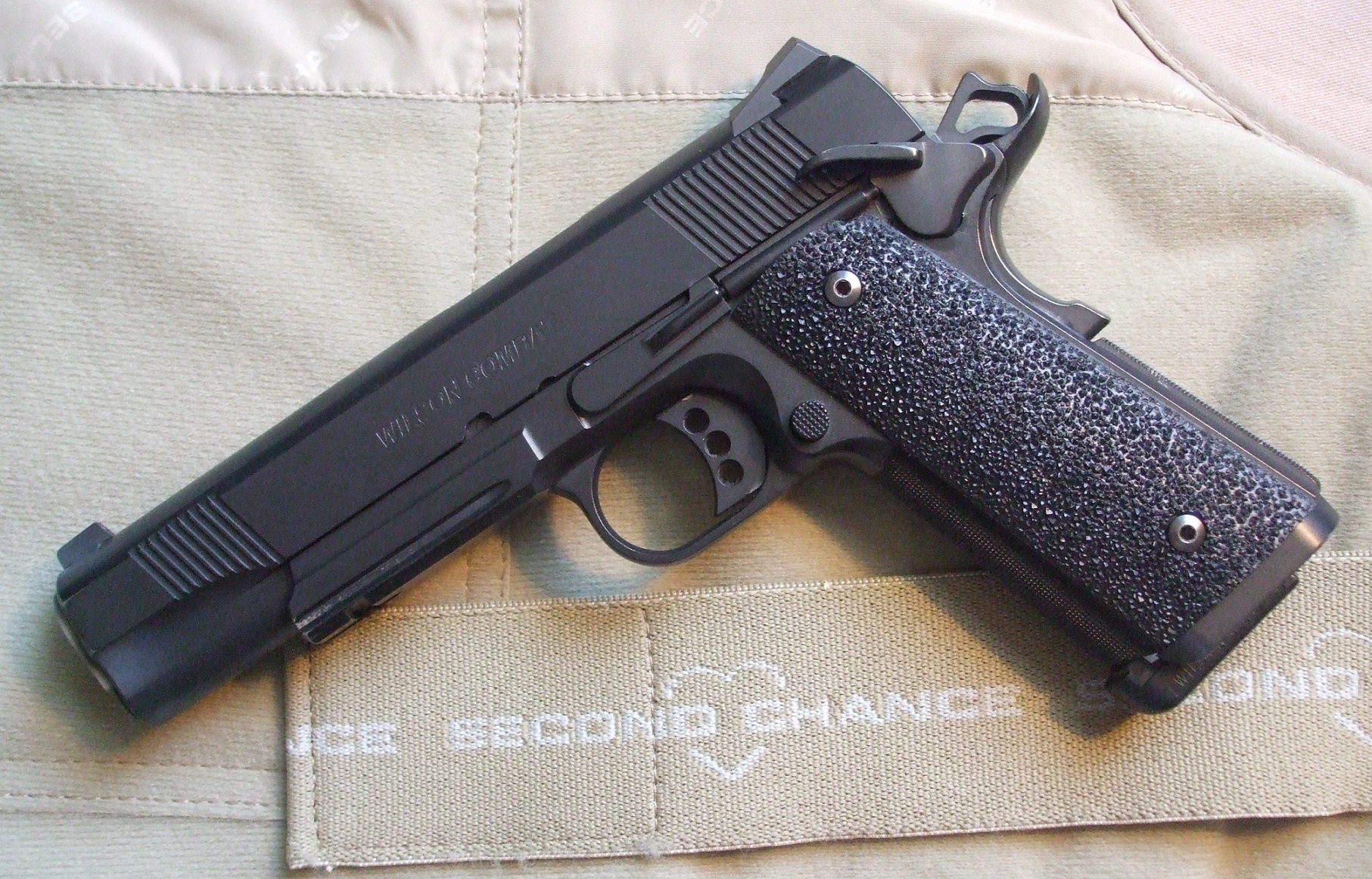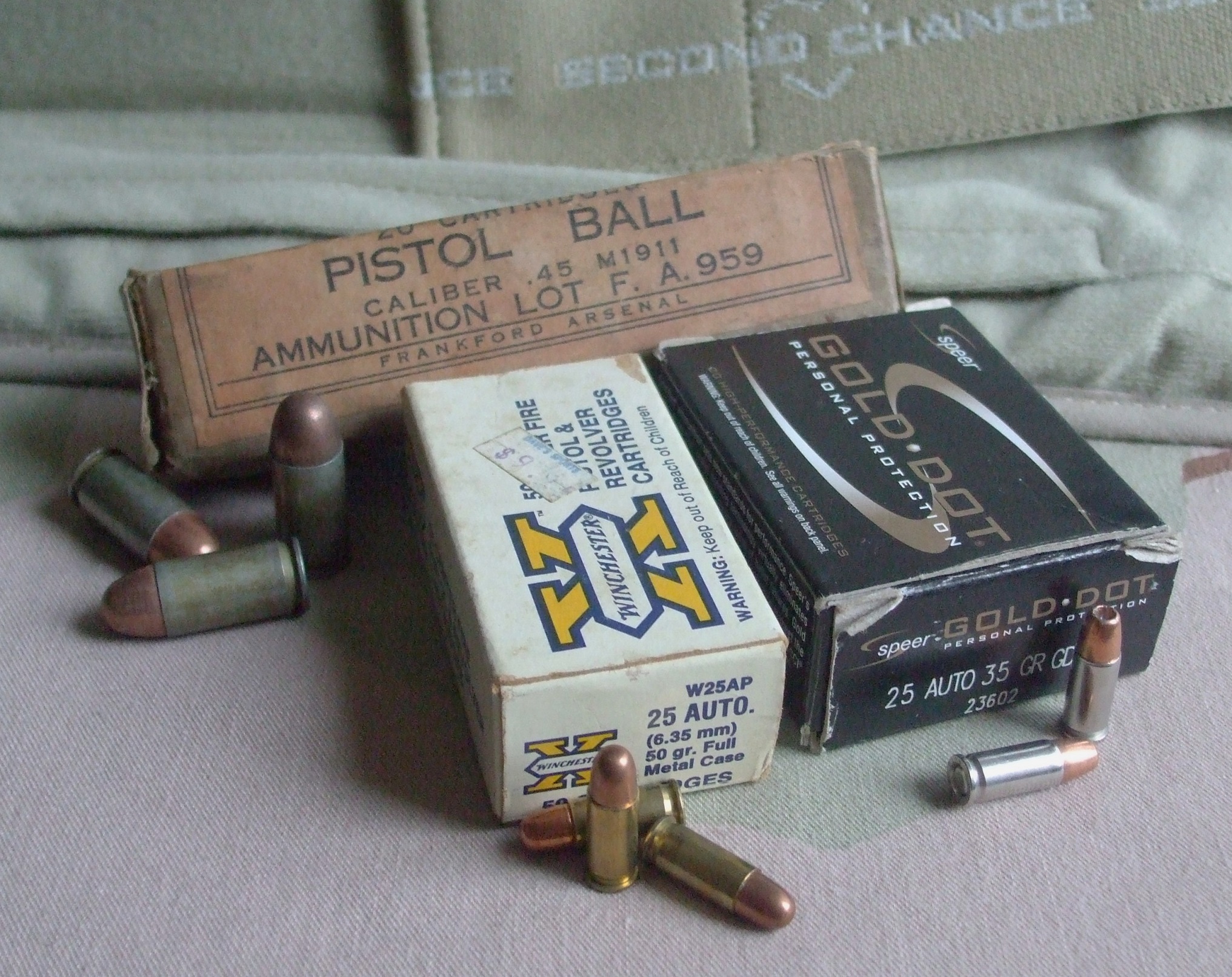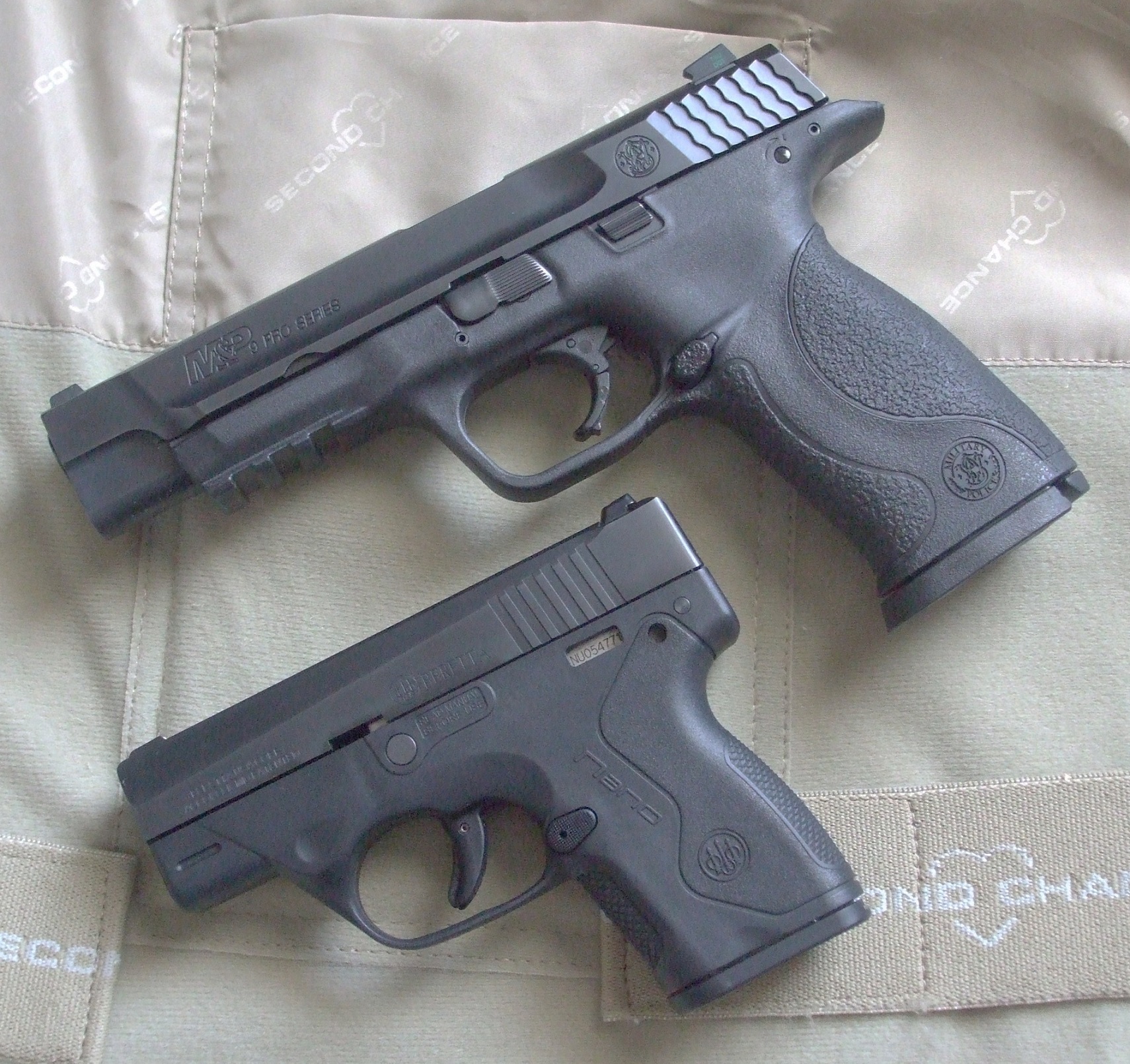
Although this holster is advertised as being the proper fit for this gun, the thumb break is clearly able to compromise the position of the thumb safety. Good gear selection is a big part of controlling variables. Photo: author
Be that as it may, it was recently pointed out that I’ve been teaching an ever-evolving form of concealed carry training in Ohio, the vast majority at Black Wing Shooting Center, for over a decade. And during that time, it was reasoned, I might have picked up on a few recurring themes that would make a worthwhile article, such as a “Top Ten Frequently Asked Questions” kind of piece.
The Scientific Method
After some consideration, I decided that it wasn’t the questions I am asked that were of particular interest — it was my answers to those questions. Or more to the point, why I answered them the way I did. To my surprise, I observed that I had applied a very basic piece of scientific methodology to almost every question I’d been asked over that ten-plus year period!
What I’m talking about is the presence of variables, all those factors great and small that play some role in any given proceeding. To conduct and evaluate an experiment, the scientific method relies on the identification and control of those variables. In the interest of the aforementioned “Top Ten” idea, I find that most any nuance of armed defense — in my experience, the answers to those frequently asked questions — can be articulated as the simple idea of controlling the variables. So rather than a laundry list of FAQs, let’s look at a few examples of how variables fit into our everyday self-defense preparation.
Self-Defense Variables
First off, consider the broad aspects of self-defense. Anything that we do, any proactive measure that we undertake to protect ourselves or our family, could rightly fit under the self-defense umbrella. For example, most of us have smoke detectors installed in our homes and most of us change their batteries on an ongoing basis. We don’t do this because we are planning to have a fire in our kitchen anytime soon. In fact, we are likely taking numerous direct measures to prevent that occurrence, such as not leaving open flames unattended. Still, we ensure that the smoke detectors are powered up and working properly in order to control that variable: if our other fire-prevention measures fail, we want the little disc on the ceiling to emit that gawd-awful shriek so we know to get ourselves out of harm’s way.
Narrow the focus a bit and look at our usual definition of self-defense: dealing with a violent criminal assault. When it comes to this sort of incident, we must acknowledge that we law-abiding civilian types rarely have much warning that violence is coming. We can debate all day about the importance of awareness and our ability to pick up the subtle indicators of an imminent attack but — a few bizarre circumstances notwithstanding — the fact remains that we tend to miss those cues completely. After all, if you knew what was about to happen, you’d get yourself out of there and to some relatively safe location. A police officer or soldier might be in a position that they recognize coming unpleasantness but are obligated to stick around anyway. You and I are mostly not in that position.
What it comes down to is this. In terms of self-defense, you do not get to control the really important variables: time, place, and circumstances. Because you do not know when, where, or under what conditions you’ll be attacked, it makes sense to pay extra attention to the variables that you can control, such as your practice, training habits, and gear.
Gear
Here’s a simple example of a gear variable: some guns have manual safeties. The safety lever can sometimes be in the “ON” position and at other times could be in the “OFF” position. Therefore, the position of the safety lever at any given instant is a variable. If the actual position of that safety in the moment of crisis is different than I believe, or than I assume, and I act on that belief or assumption, my proverbial goose could be cooked.
At the risk of having my red-blooded American tough-guy card* revoked, I argue that we get confused when we are scared and under stress — and that the variable created by the safety being “ON” or “OFF” is not only a potential catastrophe, it is completely unnecessary. Mate that safety with a decocking lever? The variables multiply. Can repetition and exposure minimize such a risk? Probably yes, but only by eating up huge amounts of training time. For the long-term gun enthusiast and avid shooter, this is less of an issue — but for the “non-hobbyist” strictly interested in defense, it will become a real problem.
Sometimes, the variable is less apparent but still needs to be controlled. If you hang around guns long enough, someone will ask you, “How long does ammunition last?” This question isn’t easy to answer because of … you guessed it … all the possible variables.
It is clearly unreasonable to assume that a cartridge, never removed from the box, and the box never removed from a climate-controlled indoor environment, will have precisely the same useful lifespan as an identical cartridge being carried daily on duty by an armed professional. What we do have is the knowledge that our ammunition will eventually deteriorate, and that certain conditions can readily accelerate that process. What we don’t have is the exact ratio of longevity, temperature, humidity, etc that renders our cartridge degraded and no longer reliable.
What we are left with is the need for some reasonable system for rotating potentially compromised ammunition out of circulation, so that its reliability is not a variable. I often think of this system as a ritual, because while I might know intellectually there is very little chance that my six-month old ammunition will malfunction, I replace it anyway. How do I know the odds say my ammo works just fine? Simple — my disposal system is to shoot it … and I’m yet to observe an age-related ammunition malfunction. Actually, I am the only component going faulty due to age!
Practice Habits
Let’s visit our practice habits for a moment. While we can go out and buy a gun without a manual safety or a holster without a thumb break, thus eliminating those variables, it is completely up to us to control how we use the equipment that we have.
It is critical that we establish consistent behaviors in our gun-handling skills. If we do it one way on Sunday and a different way on Wednesday and an entirely different way again on the Fourth of July, we’re setting ourselves up for failure. The different ways that we could perform a given task become the exact variables that we are trying to eliminate!
So if we are truly interested in becoming more efficient in our defensive skills, it is absolutely crucial that we decide on the best way to do whatever it is … then hold our own feet to the fire and always do it that way. Myriad examples exist: Which digit operates your slide lock lever? Or is it only sometimes a digit? Do you hold your gun in retention while reloading or clearing a malfunction? How about while target shooting? Do you (sometimes) lay everything out on the bench and (sometimes) poke around absentmindedly looking for a magazine?
Defending yourself with a firearm should not be like going to Baskin Robbins and wandering through 31 flavors. Our mechanical skill sets need to be chocolate or vanilla! Daydreaming about Caramel-Rum-Artichoke-Berry-Bacon-Citrus-Fudge-Nut** takes too much time in the moment of need and wastes the time we have to practice.
Identifying and controlling the variables we can while training will make it much easier to cope with the life-and-death circumstances over which we have no control.
*Just kidding — Real Men don’t need a card. **Sounds delicious. Has bacon … and rum.



I'm need 9mm
Mr. Loeffler, I couldn't agree more. An example, is my firearms of choice for both EDC and for "competition. First, let me say that No. 1, I am old. No.2, I grew up shooting 1911s and revolvers. No.3, I like handguns and own several different makes and models of pistols. I shoot them at different "competitions" although I am not really a competitor. However, to keep me from getting confused, they all share one one thing. They all have a 1911 style thumb safety. Whether shooting a competition, practicing self defense drills, or whatever, using the 1911 style thumb safety is always the same. I never have to "think" about procedure when presenting one of my pistols.
As regards your comment on the 1911 safety, the strap pictured is under the hammer. In the event the strap were to push the safety off, the hammer could not fall to hit the firing pin. In addition, the holster covers the trigger preventing anything from moving the trigger. In addition, the grip safety must be inactivated for the trigger to move. So, first the strap must push the thumb safety off. Then the grip safety must be depressed to free the trigger. Then, something of the right size size and shape must get into the holster covering the trigger to pull it and cause the gun to fire. If this unlucky cascade of errors comes about, I would suggest ducking because you are about to be hit by lightning.
Mr. Loeffler, Thank you for a very well written article. I think it was very well thought out. I am an instructor in Texas and have been training people since 1977. It amazes me how many times I see people on the range not manipulating their safety or not practicing their double action trigger pull, or just shooting at a static target while standing flat footed on a static range and think they are training. People need to learn that there is a difference between working on the fundamentals and training. Just my two cents.
I agree that what we train for should remain consistant with what works best for us. Trying different ways of handling a situation can make us confused in the heat of the moment. I (thank God) have never had to use my training in a real life situation. But there is always that possibility these day, more nso than 50 years ago when I first started to carry. I am secure and comfortable in my training to the point it is second nature to me. That does not mean I will do the same in a real life or death situation, although my 50 years at it gives me some peace. I am now retired on disability and the cost of ammo and the range are about out of my financial capacity. I go and fire my ammo every two years and have never had a misfire with my two year old ammo. I have however experienced a misfire from a new box of ammo bought at a store the same day I went shooting. old school and have always carried a .357 magnum revolver. Always. About 20 rounds into practice, my revolver failed to fire. When I tried to open the cylinder, it would not open. the gun was a lump of steel in my hand. A bad load barely fired and I did not hear it and thought it was a dummy round. Still, I could not open the cylinder, cock the gun or pull the trigger. The round was stuck between the cylinder and the barrel. I had to take it to ma gun smith who very carefully put it in his padded vise and had to tap the bullet back into the cartridge. We were then able to open the cylinder to remove the bad round am just glad I was not in a life or death situation or I could have been toast. all that aside, I am still a .357 revolver guy and consider my revolvers very reliable and easy to keep maintained in tip top shape. But that is my story of a variable I had never dreamed would happen. I guess my point is, as I do now, carry a small back-up just in case and practice with it the same way I have always practiced. what works for me is ans always be the best way for me. Old School in Kansas.
There is something that many persons can do but most likely will never consider. Martial arts training, doesn't matter what style. MA's help us prepare for the unexpected and the more training one does of time the more of that training will syphon into other aspects of self-defense. MA's also help condition the body, sharpen the mind, develop muscle memory or response habits. It can be a great addition to the self-defense preparation process. Just give it some thought.
I do control some time, place, and circumasrnces variables. I don't do stupid things with stupid people in stupid places at stupid times. Cuts the risk a lot if you're not at a strip club taking drugs at 2AM.
Re Ammo replacement every 6 months. Have you bought ammo lately ? Almost impossible to buy and costly. Hal